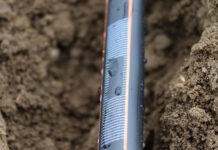
In an era of increasing water shortages, drip irrigation is popular for its water-saving efficiency that nevertheless allows plants to flourish. These systems drip water closely onto the roots of plants at low rates from mainline tubing. The plastic pipes or tubes are fitted with outlets called emitters or drippers, which are used to control the water discharge. They come in various designs, including adjustable flow emitters, inline emitters, and pressure-compensating emitters. Driplines, or drip tubing, distribute the water throughout the irrigation system and ensure water is delivered efficiently to the roots of plants.
Like any irrigation system, a drip irrigation system can encounter problems that are primarily due to incorrect installation and wrong usage of crucial components. Below, the experts at DripWorks, a manufacturer and supplier of drip irrigation systems, provide some common issues occurring with emitters and driplines, as well as the troubleshooting tips and simple repairs to address these problems.
Clogged Emitters
Clogging is the main problem with drip emitters. Emitters have tiny waterways that can be blocked if the water isn’t clean. Minerals content in water, debris, sediment, fertilizers, and chemicals we use on systems can accumulate and clog the emitters. This causes irregular water deliveries and poor plant growth. If you find uneven plant growth, reduced water flow, dry spots, or lack of water in certain areas, these are signs of clogged emitters. To prevent clogging in emitters, follow these steps:
- Flush the System. Flush the system by removing end caps on tube lines or add flush valves at the end of the lines to allow water to automatically drain after every use. Allowing water to drain from the system will help remove deposits or any loose debris that may build up in the line.
- Install a Filter. Install the filter at the start of the line to catch debris. Filters will capture debris that could clog up emitters and driplines.
- Inspect Filters & Screens. Regularly check and clean filters and screens to stop clogging. Most filters have flush valves added to the bottom of the basin for easy cleaning. If there is a screen or disc filter, simply remove the screen from the filter body to clean.
- Use Cleaning Chemicals. Use irrigation cleaning chemicals to dissolve organic material and mineral content.
- Clean or Replace Emitters. If clogging continues, consider cleaning each emitter individually or replacing emitters to provide proper water flow.
Uneven Water Distribution

Uneven water distribution is another major problem leading to over- or under-watering plants. Multiple factors, including variations in water pressure, damaged emitters, or blockage in the system can cause this problem. Due to uneven watering, some areas of the garden or landscape appear excessively dry or wet compared to surrounding areas. To address uneven water distribution:
- Replace Emitters. Replace the damaged or worn emitters with new ones. Make sure to choose the correct flow for the soil. Clay soil or poor draining soils should be watered with low flow emitters or dripline and watering times should be short.
- Check Pressure Regulators. Inspect pressure regulators to make sure they are working correctly and maintain even water pressure throughout the system.
- Adjust the Flow. Add pressure-compensating emitters or adjust the flow of individual emitters to balance water distribution.
- Adjust Emitter Spacing. If some areas in the property receive plenty of water, adjust the spacing between emitters to achieve more consistent coverage.
Leaking Emitters or Driplines
Leakage in driplines or emitters can lead to reduced system efficiency, water waste, and damage to the surrounding area. Leaks occur due to damaged or worn components, cracked emitters, punctured driplines, or loose fittings. Signs of leakage include reduced water flow in some areas, wet spots around driplines or emitters, and any visible damage to components. Here’s how to address leaks in emitters and driplines:
- Repair or Replace Leaking Components. Check out the emitters and driplines thoroughly and replace or repair the faulty component, depending on the extent of the damage. Cut out damaged emitters in driplines and add a coupler to fix the lines and replace emitters with new ones.
- Identify Source of Leakage. Scrutinize the drip irrigation system to find the sources of leaks, such as loose connections, damaged emitters, or holes in the line.
- Ensure Proper Assembly. Make sure all the connections are tight, secure, and correctly assembled to avoid future leaks.
Low Water Pressure or Flow
Low water pressure or insufficient water flow in a drip system can result in insufficient irrigation and compromised plant growth. Low pressure or flow can be caused by various factors, including leaks in the system, clogged filters, inadequate water supply, or valve malfunctions. However, signs of low water pressure or water flow in the system include slow irrigation progress, weak water flow from drip emitters, or uneven watering. To increase water pressure and flow, follow these steps:
- Examine Valves. Inspect electric and battery valves. Make sure they are not clogged or malfunctioning due to an old solenoid. Replace the valve or solenoid if needed. If using manual valves, make sure that the valve is not damaged or broken.
- Check Water Source & Pressure Regulator. Make sure the water source is providing enough water flow and pressure. If the water supply is inadequate, upgrade to a larger water source or split out your garden into smaller watering zones.
- Clear Blockages. Check emitters, filters, or screens for clogs or debris. Clean the components to restore good water flow.
- Divide System into Zones. If your drip irrigation system has many plants with distinct watering needs, divide it into smaller zones to handle pressure effectively.
- Install Booster Pump. If the problem persists, it is recommended to install a booster pump to increase water flow and pressure.
Maintaining an efficient drip irrigation system requires cautious troubleshooting and preventive measures. By understanding the common problems with emitters and driplines and implementing suitable solutions, you can increase the functioning of a system and promote plant growth. Regular maintenance, proper filters, and monitoring water quality can help avoid these drip irrigation problems and ensure the system’s long-term functioning.
 DripWorks carries a large selection of emitters and driplines for drip irrigation systems. The company’s collection of drip irrigation kits is extremely popular among customers. Sign up for Pro Member pricing by registering here.
DripWorks carries a large selection of emitters and driplines for drip irrigation systems. The company’s collection of drip irrigation kits is extremely popular among customers. Sign up for Pro Member pricing by registering here.
This article is adapted from an original found here.
For more articles on water and irrigation, see:
The Best Drought & Flood Tolerant Plants
A Balanced Approach To Landscape Irrigation
Water Conservation Lessons From California











![[VIDEO] Dickies®: Discover Workwear That’s Anything But Uniform](https://turfmagazine.com/wp-content/uploads/2023/06/1647663814-4b1a2a7742790a9b1e97a3b963477850192e1d6a9dfba9b07214a77bae25d6e3-d-218x150.jpg)






























![[VIDEO] Dickies®: Discover Workwear That’s Anything But Uniform](https://turfmagazine.com/wp-content/uploads/2023/06/1647663814-4b1a2a7742790a9b1e97a3b963477850192e1d6a9dfba9b07214a77bae25d6e3-d-324x160.jpg)